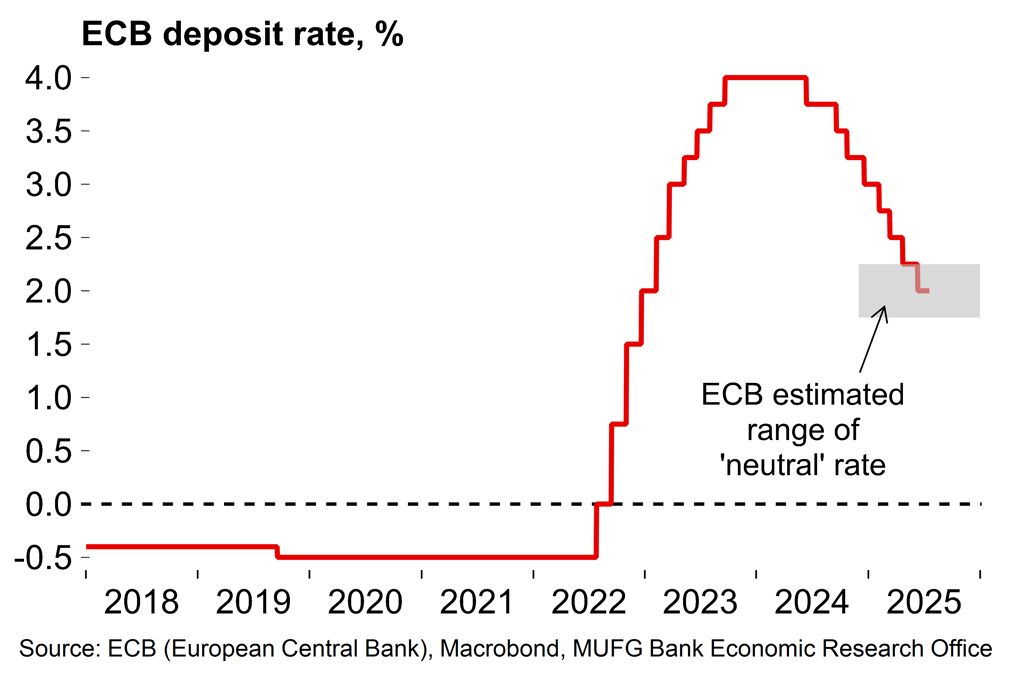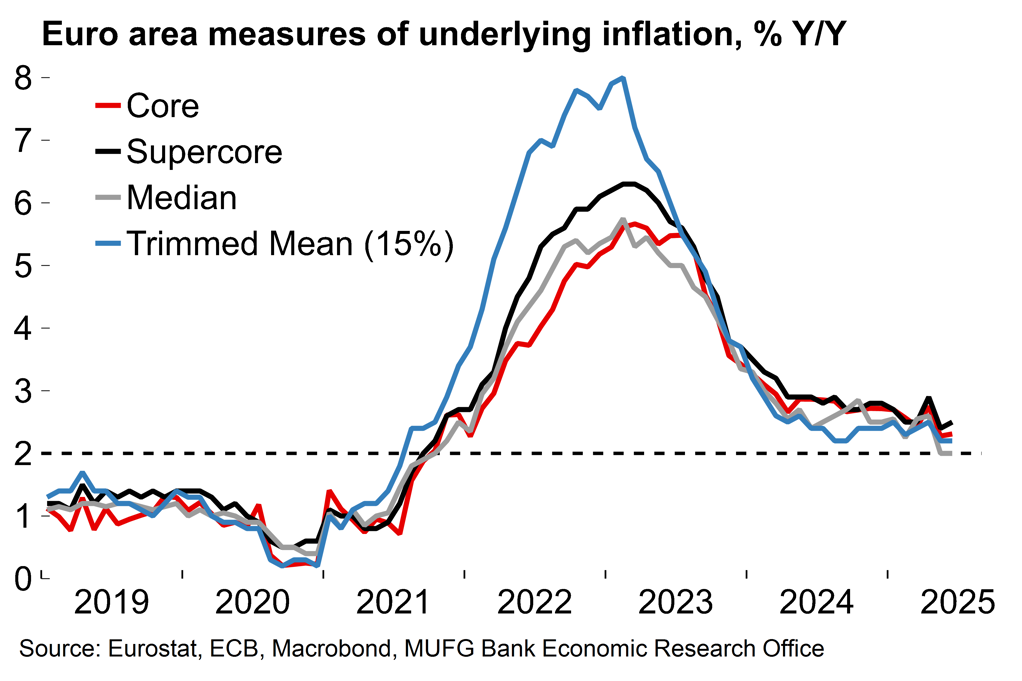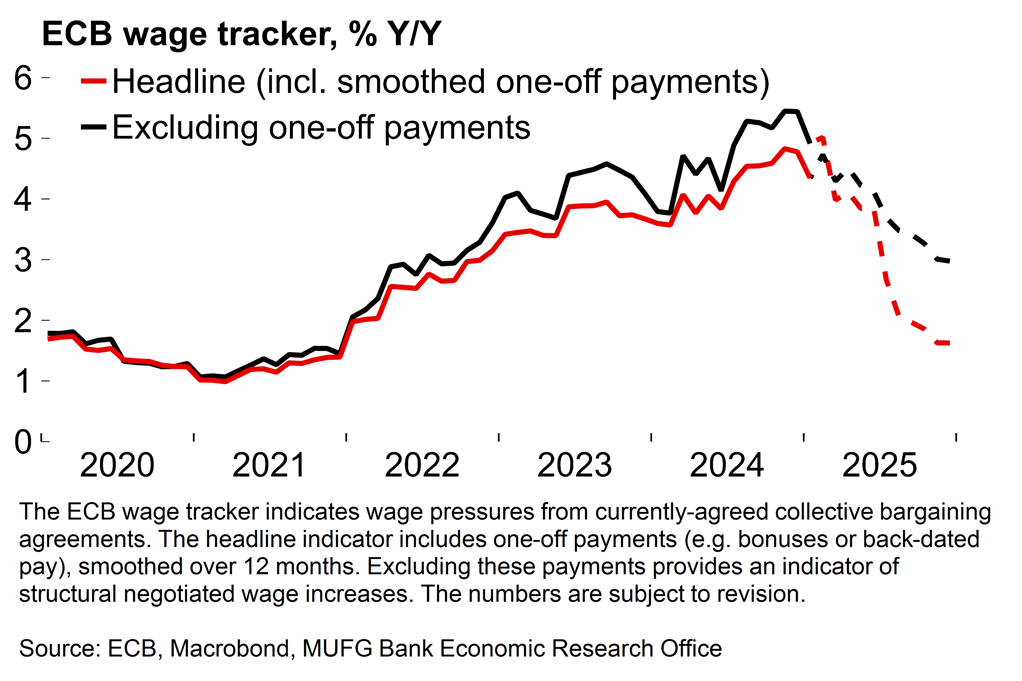- The ECB is set to pause this week after seven straight cuts. With inflation on target and policy ‘in a good place’ there’s little pressure to act now. Indeed, policymakers will likely be content with current market pricing for one more cut this year and we expect there will be a desire to avoid any comments which might dislodge that.
- Uncertainty around US-EU trade continues to cloud the outlook. The landing ground for a deal could still be small. But even in the case of a benign outcome (i.e. US tariffs around 10%) we still see scope for further easing as the disinflation process broadens between an energy/FX story later in the year.
In a good place (except for trade uncertainty)
After seven cuts on the spin, the ECB is set to leave rates unchanged at this week’s meeting with the first pause since July 2024. The deposit rate is now at 2.0%, the midpoint of the range of ‘neutral’ estimates (1.75 – 2.25%) published by the ECB earlier this year (see here). As we said in our review of that meeting, the bar for further easing seems higher now that the neutral mark has been reached.
On paper this looks like a low-key meeting. In the last press conference, President Lagarde said three times that the ECB is “in a good place”, and that still holds. Policy is at neutral and inflation was confirmed at 2.0%, bang on target, in last week’s final HICP release for June. Oil prices have settled slightly higher than anticipated at the time of the ECB’s last projections, but a stronger euro is set to offset the inflationary implications of that. Our FX strategists have raised their EUR/USD forecasts.
There hasn’t been a huge amount of economic data since the last meeting, but releases have generally been more on the hawkish side. While we still expect a mild Q2 GDP contraction after the fast start to the year, industrial production figures for May eased fears of a sharp slowdown. Last week’s German ZEW survey was also notably upbeat at the start of Q3.
But that is counterbalanced by still-high uncertainty around US-EU trade. Earlier this month there was optimism that the framework for a deal was largely in place. Now it seems that officials on the EU side may have been a little premature to celebrate progress, and there has been pressure on Brussels to show more teeth with its possible countermeasures.
There was some more positivity this weekend with US commerce secretary Lutnick saying “I am confident we’ll get a deal done”, yet it still seems like a narrow path to our minds. Assuming that US tariffs are here to stay, the question ultimately boils down to whether 1) the EU can swallow an unbalanced outcome which is tilted in favour of the US, or 2) whether Trump would accept some form of EU countermeasures without ratcheting up tariffs further.
So, as we approach Trump’s current 1 August deadline for a deal, the landing ground for a deal still looks small and there is plenty of risk that things could go south. That was a key factor behind our call for the ECB to cut into marginally accommodative territory (i.e. to 1.50%). If a relatively benign trade outcome is ultimately reached (i.e. one that sees the US tariff rate settle at 10%) then we’d likely scale back that call for further cuts.
The ECB has brought policy back to neutral

Stronger EUR set to reinforce the disinflation process

We still see scope for further easing as the disinflation process broadens
We still think there’s scope for some further easing regardless of the outcome of trade talks. There will be a slew of key data releases between now and the next meeting in September, including on Q2 GDP (which is set to slow sharply) and compensation per employee (which is likely to show pay growth easing). Against that background we believe that policymakers will find it harder to argue that the disinflation process is contained to a simple energy/FX story if headline rates start to undershoot again, as is likely in the July/August figures. We also highlight that while there is substantial German fiscal stimulus coming down the track, the picture is very different in the euro area’s second largest economy (see here for our take on the 2026 French budget announcement).
For now, the ECB will want to remain flexible. The current guidance (“data-dependent”, “meeting-by-meeting” and without pre-commitment to a particular rate path) is set to be left unchanged. We suspect that policymakers will be content with current market pricing, which seems well-anchored around 25bp of further cuts this year, and will try to avoid making any comments (e.g. on trade or FX risks) which might shift that. A low-key meeting ahead of the summer break – but it's clear that the ‘good place’ would look better if it weren’t for the cloud of tariff uncertainty.
Underlying inflation is close to target…

…and wage pressures are set to cool

